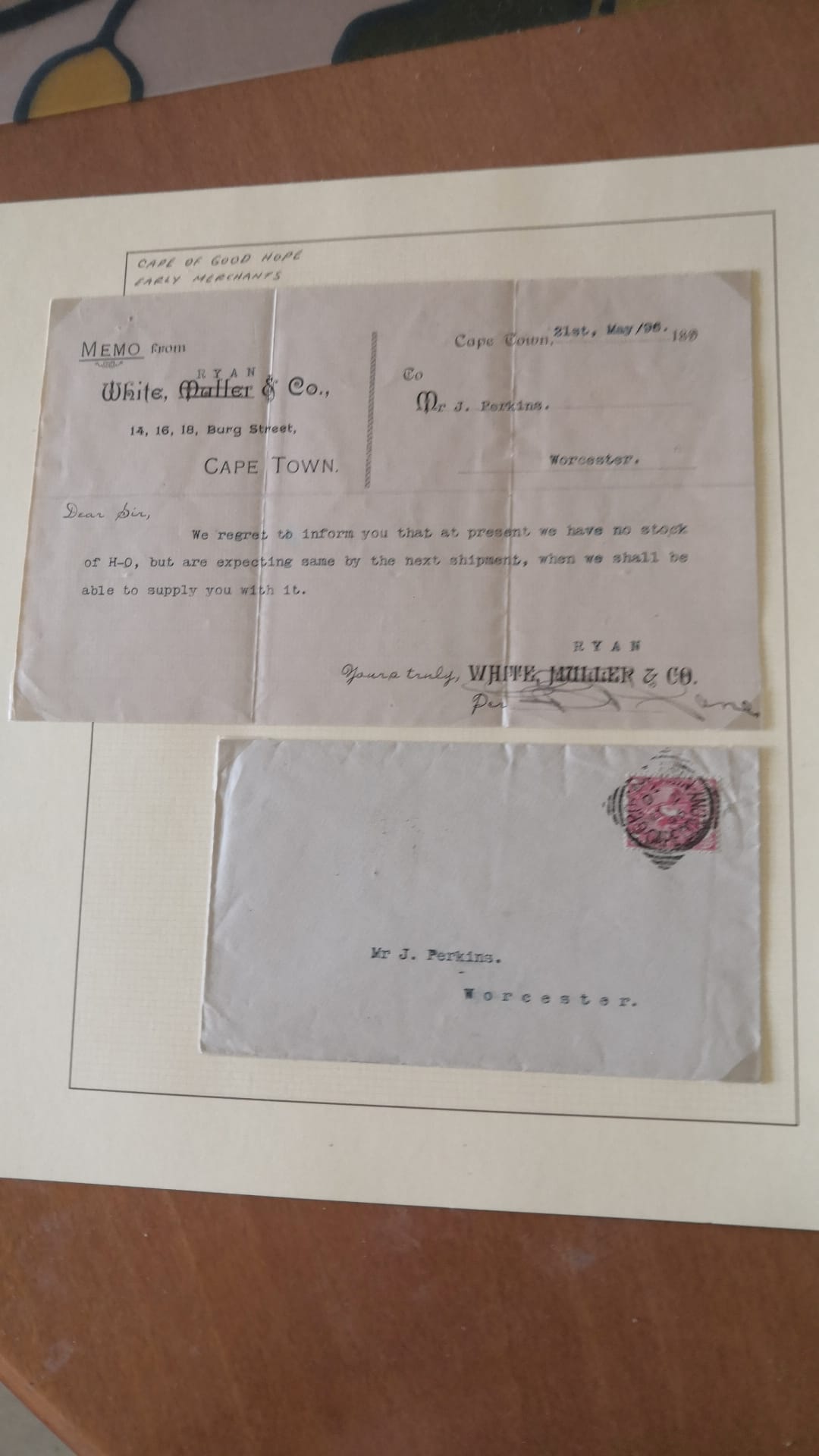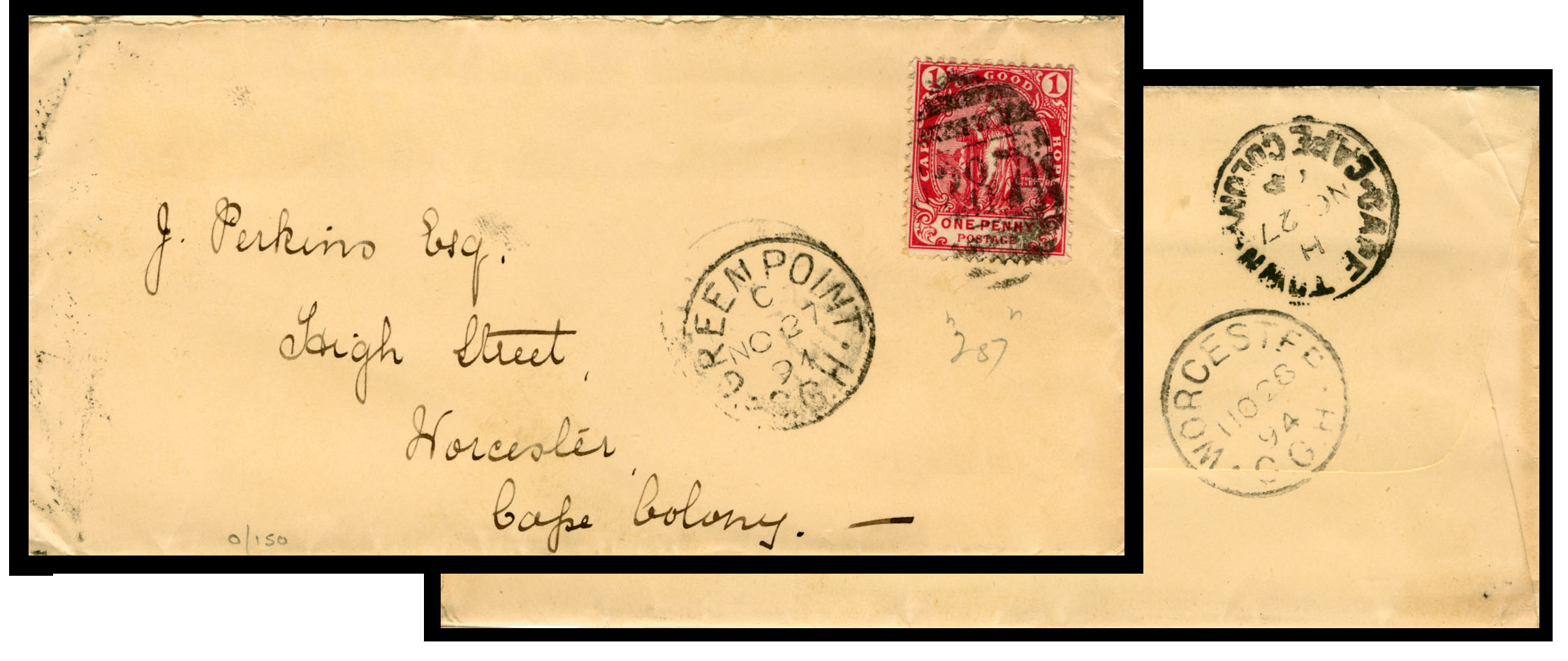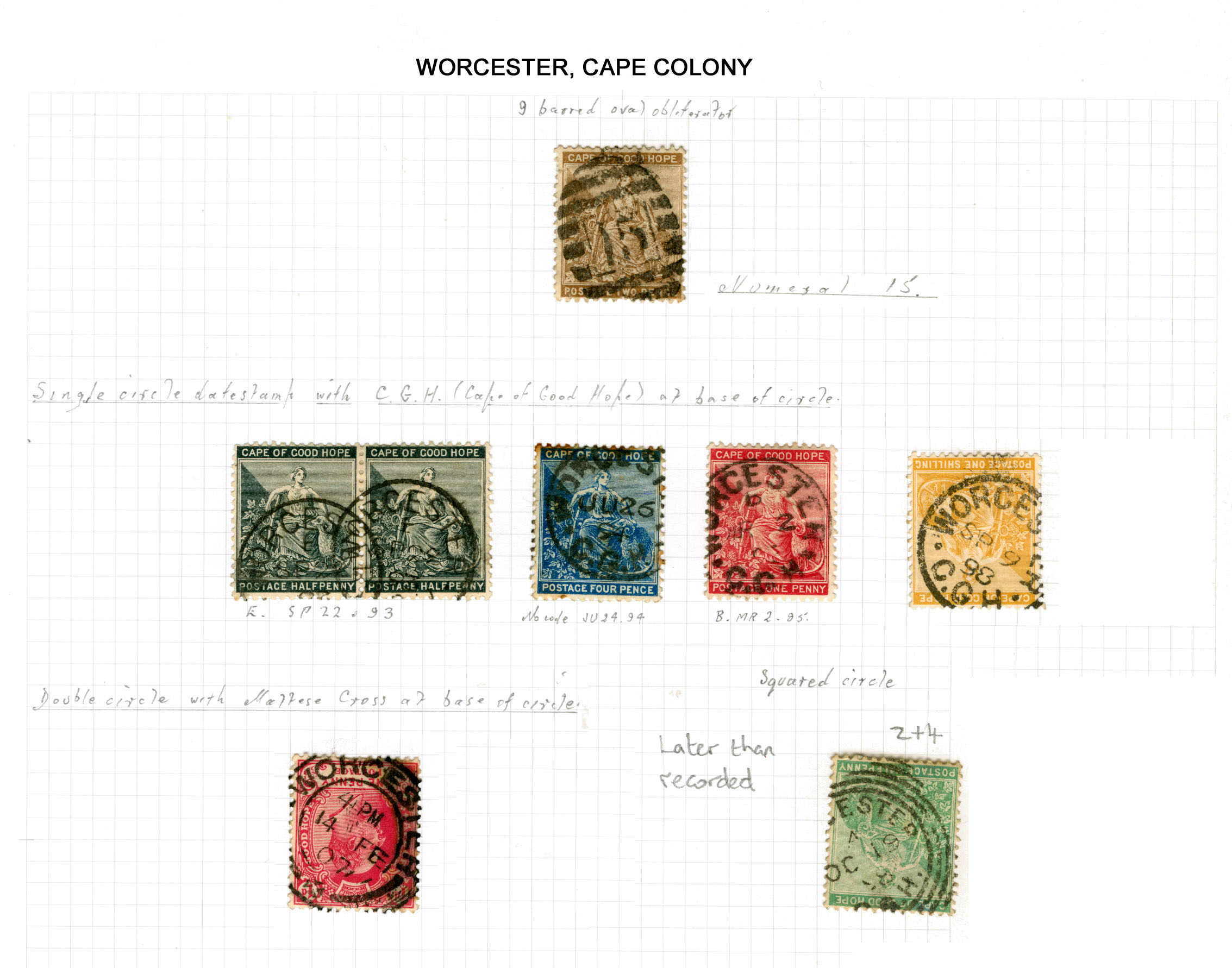From the Postbag of J Perkins, Worcester.
Quote from Steve on May 14, 2023, 5:33 pmView Gawie Hugo's 'From the Postbag of J Perkins, Worcester' here.
If you read Gawie Hugo's contribution to the Club on the postal history of Worcester as found in the postbag of James Perkins, father and son, please Reply with your comments below. This display is in Afrikaans. A translation is supplied for non-Afrikaans speakers.
Unlike some, I have only collected 'Perkins' Worcester material in a desultory fashion when it supplemented my collecting of wider Cape postmarks. Nevertheless, I have some good and great material that has come down to me through their appreciation of it as a record of their time on earth, no doubt something that they believed might one day "be important to historians and worth something!".
As one of two main sources of Cape postmarks (the other is E Burmester in Cape Town), the accumulation of James Perkins senior as added to and stored for posterity by his son comprises a vital source of 19th century Cape commercial postal history. I cannot think of another Cape company, (yes, Burmeister in East London provided a similar trove but this was more modern 20th century South African material), that ranks close to these two enterprises who thought their correspondence worth keeping. Without the Perkins trove our hobby would be much the poorer. In thanking Gawie for sharing his display with us, we should also be grateful to the Perkins family who had the good sense not to throw this material away, use it as toilet paper or light the kitchen fire with it on icey Boland mornings.
View Gawie Hugo's 'From the Postbag of J Perkins, Worcester' here.
If you read Gawie Hugo's contribution to the Club on the postal history of Worcester as found in the postbag of James Perkins, father and son, please Reply with your comments below. This display is in Afrikaans. A translation is supplied for non-Afrikaans speakers.
Unlike some, I have only collected 'Perkins' Worcester material in a desultory fashion when it supplemented my collecting of wider Cape postmarks. Nevertheless, I have some good and great material that has come down to me through their appreciation of it as a record of their time on earth, no doubt something that they believed might one day "be important to historians and worth something!".
As one of two main sources of Cape postmarks (the other is E Burmester in Cape Town), the accumulation of James Perkins senior as added to and stored for posterity by his son comprises a vital source of 19th century Cape commercial postal history. I cannot think of another Cape company, (yes, Burmeister in East London provided a similar trove but this was more modern 20th century South African material), that ranks close to these two enterprises who thought their correspondence worth keeping. Without the Perkins trove our hobby would be much the poorer. In thanking Gawie for sharing his display with us, we should also be grateful to the Perkins family who had the good sense not to throw this material away, use it as toilet paper or light the kitchen fire with it on icey Boland mornings.
Quote from yannisl on May 15, 2023, 3:04 pmMany thanks to Gawie and you Steve, for publishing this interesting exhibit here. Social philately is gaining traction as there is so much to discover and enjoy as compared to traditional displays of stamps or postal history. As you write the Perkins correspondence has provided so much material and information to the study of the Cape of Good Hope philately. Although not all the material is in good condition, as one would expect, it is unique in that it provides a continuum of material virtually on a week by week basis. The fact that many of the correspondence includes the actual letters, provides a rare glimpse to the merchants of the Cape of Good Hope. Perkins like many others at the time kept track of orders and payments by keeping the envelopes and sometimes scribbling at the back. As the railways rushed to expand their reach to Kimberley, Perkins used the mail to ship goods to the Kimberley area. I would have loved to know more about him as a person and there is virtually nothing about his wife published. He also seems to have invested in the stock exchange, as I have some of his correspondence from a broker, but sadly no enclosures.
Many thanks to Gawie and you Steve, for publishing this interesting exhibit here. Social philately is gaining traction as there is so much to discover and enjoy as compared to traditional displays of stamps or postal history. As you write the Perkins correspondence has provided so much material and information to the study of the Cape of Good Hope philately. Although not all the material is in good condition, as one would expect, it is unique in that it provides a continuum of material virtually on a week by week basis. The fact that many of the correspondence includes the actual letters, provides a rare glimpse to the merchants of the Cape of Good Hope. Perkins like many others at the time kept track of orders and payments by keeping the envelopes and sometimes scribbling at the back. As the railways rushed to expand their reach to Kimberley, Perkins used the mail to ship goods to the Kimberley area. I would have loved to know more about him as a person and there is virtually nothing about his wife published. He also seems to have invested in the stock exchange, as I have some of his correspondence from a broker, but sadly no enclosures.
Quote from yannisl on May 16, 2023, 8:59 amOutside the shop there is a sign H-O, does anyone know what this is? Apparently in 1896, the Agents run out of stocks.
Outside the shop there is a sign H-O, does anyone know what this is? Apparently in 1896, the Agents run out of stocks.
Uploaded files:Quote from Steve on May 16, 2023, 12:41 pmGlad you're eating this up. I love the direction of your post!
'H-O' is apparently 'Hornby's Oats', an American quick-cooking oats product. See:
https://www.fadingad.com/fadingadblog/2012/02/06/eat-h-o-quaker-oats-ad-nypl-digital-gallery-brooklyn-terminal-brooklyn-bridge/
How did the translation work for you? Was it needed or does the postal history speak for itself?
Your memo above is typewritten and is a relatively early eaxmple of the typerwriter's use in South Africa. I picked up on this while researching William Hoy, later Sir William Hoy, for a display on Hermanus. Hoy was “The S.A.R. Colossus”. He was recruited by the Cape Government Railways while still a young man in Scotland. He emigrated to South Africa and took up employment in Cape Town in 1889. While still in Scotland he became convinced that shorthand and typing would become very important in business and qualified himself in both. He brought his personal typewriter with him to South Africa, and it is thought to be the first ever used in business in the country. One commentator has jokingly claimed that Hoy was the first and only ‘shorthand-typist’ to become General Manager of South African Railways.
Now, let's all rush out to document our typewritten postal history correspondence by earliest date!
Glad you're eating this up. I love the direction of your post!
'H-O' is apparently 'Hornby's Oats', an American quick-cooking oats product. See:
Eat H-O & Quaker Oats Ad — NYPL Digital Gallery – Brooklyn Terminal @ Brooklyn Bridge
How did the translation work for you? Was it needed or does the postal history speak for itself?
Your memo above is typewritten and is a relatively early eaxmple of the typerwriter's use in South Africa. I picked up on this while researching William Hoy, later Sir William Hoy, for a display on Hermanus. Hoy was “The S.A.R. Colossus”. He was recruited by the Cape Government Railways while still a young man in Scotland. He emigrated to South Africa and took up employment in Cape Town in 1889. While still in Scotland he became convinced that shorthand and typing would become very important in business and qualified himself in both. He brought his personal typewriter with him to South Africa, and it is thought to be the first ever used in business in the country. One commentator has jokingly claimed that Hoy was the first and only ‘shorthand-typist’ to become General Manager of South African Railways.
Now, let's all rush out to document our typewritten postal history correspondence by earliest date!
Quote from yannisl on May 16, 2023, 4:21 pmHi Steve, the translation worked well for me. I quickly paged through the display and read the Afrikaans. 3-4 items I did not understand well, then went read your translations and came back and spent more time on the display. I think your method is very convenient. I would certainly have to relook at a lot of my material and add to the story.
Thanks for the info on the use of typewriters and William Hoy. I remember having a letter I think from a lady to her father that was fully typewritten and she mentioned she was studying Greek and typing at a College, I think it was Wellington, but cannot find it now.
Thanks also for solving the H-O puzzle for me, I was up to my ears looking for chemicals!
Hi Steve, the translation worked well for me. I quickly paged through the display and read the Afrikaans. 3-4 items I did not understand well, then went read your translations and came back and spent more time on the display. I think your method is very convenient. I would certainly have to relook at a lot of my material and add to the story.
Thanks for the info on the use of typewriters and William Hoy. I remember having a letter I think from a lady to her father that was fully typewritten and she mentioned she was studying Greek and typing at a College, I think it was Wellington, but cannot find it now.
Thanks also for solving the H-O puzzle for me, I was up to my ears looking for chemicals!
Quote from Steve on May 27, 2023, 6:02 pmHere is a cover from Green Point to Perkins in Worcester. Of note is the Green Point BONC 287. I imagine it is uncommon but not scarce. Given my new interest in time code letters what is also interesting about this is that it was posted at 'C' in Green Point and received in Cape Town at 'H' the same day. Presumably it caught the first available train to arrive in Worcester at BLANK the next day. From my experience of passenger train travel on SAR in the 1960s, the overnight train to Jo'burg usually departed at 10 am or thereabouts. I can't remember how long it took to reach Worcester but I imagine that it would probably take 2-3 hours in 1894?
I also include a few stamps that I found recently among my accumulation. Yes, I'm scraping the barrel, I know!
Here is a cover from Green Point to Perkins in Worcester. Of note is the Green Point BONC 287. I imagine it is uncommon but not scarce. Given my new interest in time code letters what is also interesting about this is that it was posted at 'C' in Green Point and received in Cape Town at 'H' the same day. Presumably it caught the first available train to arrive in Worcester at BLANK the next day. From my experience of passenger train travel on SAR in the 1960s, the overnight train to Jo'burg usually departed at 10 am or thereabouts. I can't remember how long it took to reach Worcester but I imagine that it would probably take 2-3 hours in 1894?
I also include a few stamps that I found recently among my accumulation. Yes, I'm scraping the barrel, I know!
Uploaded files:


